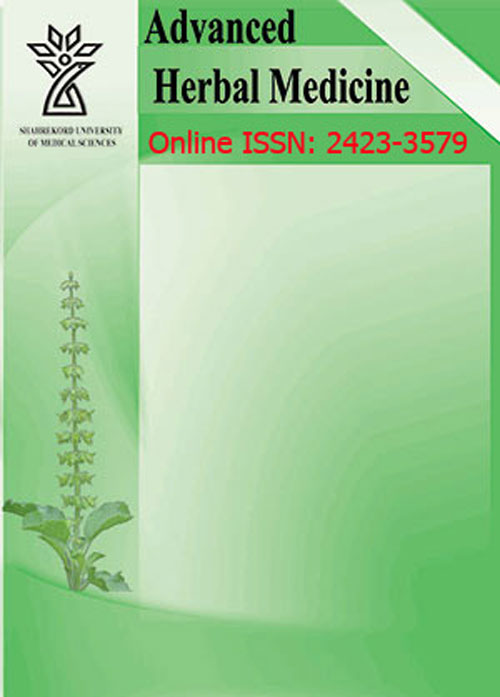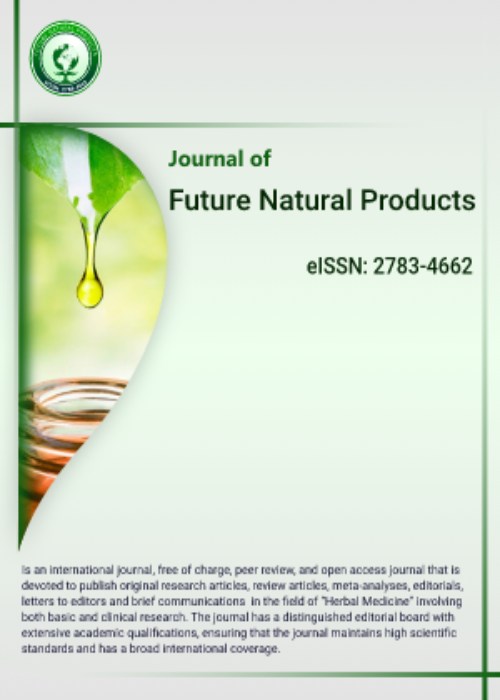فهرست مطالب

Future Natural Products
Volume:1 Issue: 4, Autumn 2015
- تاریخ انتشار: 1394/10/30
- تعداد عناوین: 8
-
Pages 1-8Background And AimsHuman adenoviruses can cause a diversity of clinical diseases, but there is no antiviral therapy formally approved by adenovirus infections. Thus, antiviral agents derived from medicinal plants which are effective against adenoviruses infections are urgently required. Therefore, this research was aimed to evaluate in vitro antiadenovirus activity of pomegranate (Punica granatum L.) peel extract.MethodsIn this research, crude ethanol extract of pomegranate peel was prepared. Anti-adenovirus activity of the extract was evaluated on Hela cell line using MTT (3-[4,5-dimethylthiazol–2-yl]-2,5-diphenyltetrazolium bromide) assay. The 50% inhibitory concentration (IC50) and 50% Cytotoxicity Concentration (CC50) of the extract were determined using regression analysis. To determine antioxidant activity, total phenol content, and flavonoids content of the extract, the 2, 2-diphenyl-1-picrylhydrazyl (DPPH) assay; Folin-Ciocalteu method and aluminum chloride colorimetric method was used, respectively.ResultsThe CC50 and IC50 of the extract were 165±10.1 and 18.6±6.7µg/ml, respectively. The selectivity index (SI), the ratio of CC50 and IC50, was 8.89. The IC50 of DPPH radical was 7.7±1.21 μg/ml, compare with butylated hydroxytoluene (BHT), with IC50 of 25.41±1.89 μg/ml. The total phenol and Flavonoid contents were 282.9 mgGAE/g and 136.6mg/g, respectively. This study revealed that the pomegranate (Punica granatum L.)Conclusionpeel extract exhibited Anti-adenovirus activity, with SI value of 8.9, suggesting its potential use as Anti-adenovirus agents. Also this extract with high phytoconstituents could be a promising source of medicinally important natural compound.Keywords: Antioxidant activity, Antiviral activity, Punica granatum L, pomegranate peel, Antiadenovirus
-
Pages 9-15Background And AimsSafflower (Carthamus tinctorius L.)from Asteraceae family has different biological activities including analgesic, antidepressant, anti-inflammatory, antispasmodic and neuroprotective effects. This study designed to evaluate its effect on naloxone -induced morphine withdrawal signs.MethodsIn this experimental study, male NMRI mice (25-30 g) were randomly divided into 5 groups of 8: control groups received morphine and normal saline (10ml/kg) and other groups received fluoxetine (20mg/kg) and different doses of ethanolic extract of Safflower (100,200 and 400mg/kg).Morphine dependency was induced by intraperitoneal (i.p.) injection of increasing doses (50-75 mg/kg) of morphine. Withdrawal signs were elicited by naloxone (5mg/kg, i.p.) and number of jumpings and also presence of climbing, writing, wet dog shakes, teeth chattering, diarrhea, grooming and rearing during a 30 min period.ResultsThe ethanolic extract at all doses (100, 200 and 400 mg/kg, i.p., p<0.001) and fluoxetine (20mg/kg, i.p., p<0.01) significantly inhibited the number of jumps. Additionally, all doses of extract reduced the grooming and writing (p<0.05).Only 200 and 400 mg/kg of extract reduced the other checked signs including climbing, rearing and teeth chattering. All doses of extract couldn’t reduce wet dog shake and diarrhea significantly (p>0.05). Fluoxetine significantly inhibited the other signs except wet dog shakes and diarrhea.ConclusionThese findings indicated that Safflower extract has therapeutic potential in management of opiate withdrawal signs and this is comparable to the effect of fluoxetine. However, further studies need for clarify their exact mechanism of action.Keywords: Safflower, morphine, dependence, withdrawal signs, naloxone
-
Pages 16-20Aloe Vera is a medicinal plant as antioxidants reduce cell damage and used. The purpose of this study was to determine the effect of Aloe Vera on lactate de-hydrogenase after a period of aerobic exercise in male athletes.Methods This study applied the method according to the nature of the study, based on semi-empirical research and a review of the pre-test, post-test supplements and placebo groups, respectively. In this study,20 male students weight was 64.85 ±. 51 and height was 172.05 ± 6.4 were randomly assigned to two groups of Imam Ali College of Physical Education Supplement (n = 10) and placebo (10 people). Then aerobic training was conducted for 4 weeks in the supplemented group were taking 3 capsules, each capsule contains 2 grams of dried Aloe Vera and placebo group were taking 3 capsules containing Dextrin daily after every meal. To determine the index of LDH were used and blood samples were collected 24 hours before and after each test Cooper with student in the lab. To describe data, analytical data, and for the mean and standard deviation of repeated measures ANOVA and independent T-test was used for comparison between groups Significance level was P ≤ 0.05.The use of Aloe Vera during aerobic exercise significantly, cautious reduced LDH (P=0.006) in the supplement group compared to placebo was 15% reduction.ConclusionOverall the findings of this study showed that Aloe Vera reduces lactate de-hydrogenase. This result may reflect the role of Aloe Vera has anti-inflammatory and antioxidant.Keywords: Aloe Vera, lactate de, hydrogenase, Antioxidant, boys, Athletic
-
Pages 21-27Background And AimKelussia odoratissima Mozaff. is an Iranian endangered endemic plant which widely used in the Central Zagros region of Iran as spice and medicinal herb for inflammatory and cardiovascular purposes. The aim of this study was to assess the essential oil compositions of Birahgan ecotype of K. odoratissima in Chaharmahal and Bakhtiari province.Methodsthis is a fundamental research. The aerial parts of K. odoratissima were collected from Birahgan ecotype then were dried. The essential oils were obtained by hydro-distillation and were analyzed by Gas Chromatography-Mass Spectrometry.ResultsTwenty-four compounds were identified, of which the major components were found to be Z-ligustilide (64.3%), 2-octen-1-ol acetate (12.0%), (Z)-3-butyldiene phthalide (4.5%), menthyl acetate (3.0%), α-copaene (2.8%), δ-cadinene (2.2%), neo-menthol (1.6%), menthol (1.5%) and α-cadinene (1.5%). Phthalides are rich in the essential oil of K. odoratissima. The group of phthalides was included as Z-ligustilide, E-ligustilide, (Z)-3-Butyldiene phthalide and (E)-3-Butyldiene phthalide, which these compounds formed (70.10%) major content of all identified components.ConclusionLike other ecotypes, the ecotype of Birahgan is a rich source of Z-ligustilide and phthalide that can be used in the pharmaceutical industries.Keywords: Birahgan, Central Zagros, Essential oil, Z, ligustilide, wild celery, Kelussia odoratissima Mozaff
-
Pages 28-34Background And Aimsosteoarthritis is one of the most common arthritis in elderly. we evaluated to compare the effect of topical application of Eugenia caryophylata extract and topical diclofenac in primary knee osteoarthritis.MethodsThis randomized double-blind clinical trial study was carried out upon 105 patients with primary knee osteoarthritis. Patients were selected randomly and divided into three groups of 35(diclofenac) and 35 (Eugenia caryophylata) and 35(placebo).The first group was given three times diclofenac 1% of one mg, the second group was given topical caryophylata 10% of one mg three times daily and third group was given placebo 1 mg three times daily. For three groups, WOMAC questionnaire (overall pain, knee pain, morning stiffness, stiffness during day, physical activity) were completed pretreatment, one week and three and four weeks post-treatment.FindingsThe findings indicated that there is a significant decrease in overall pain (p=o.oo5), stiffness during day (p=0.001), morning stiffness (p=0.001) and knee pain (p=0.017) and physical activity (p=0.001) in four weeks after the initiation of treatment in three groups of topical Eugenia caryophylata, diclofenac and placebo. In all the three groups, mean overall score of womac questionnaire was significantly decreased. no side effects related to the intake of medication in three groups was observed.ConclusionExtract of Eugenia caryophylata is effective in decreasing knee pain, morning stiffness, and stiffness during day and improvement of physical activity in patients with knee osteoarthritis and it can be used alongside of chemical medication to reduce symptoms of knee osteoarthritis.Keywords: knee osteoarthritis, Eugenia caryophylata¸ placebo, pain¸ diclofenac
-
Pages 35-42Background And AimsThe spice Zingiber officinale or ginger possesses antioxidant and neuroprotective effects. In this study we hypothesized that treatment with hydroethanolic extract of ginger (50, 100 and 200 mg/kg, p.o) would have an effect on the scopolamine-induced memory impairment in rats.MethodsIn this experimental study, 64 male Wistar rats were divided into eight groups (8 rats in each group): normal saline, scopolamine (1 mg/kg), ginger extract (50, 100 and 200 mg/kg), or scopolamine (1 mg/kg) plus ginger extract (50, 100 and 200 mg/kg). Memory impairment was induced with a single injection of scopolamine (1 mg/kg, i.p). Cognitive functions were evaluated using passive avoidance learning (PAL) task. Retention test was carried out 24 hours after training, and the latency of entering the dark compartment [step-through latency (STL)] and the total time in the dark compartment (TDC) were recorded. All statistical analysis was carried out at 5% level of significance using SPSS version 21. The data were analyzed by ANOVA followed by Tukey’s test.ResultsThe time latency in scopolamine-treated group was lower than control (p<0.001). Treatment of the animals by 100 and 200 mg/kg of ginger extract before the training trial increased the time latency at 24 h after the training trial (p<0.01). Also, administration of extract at doses of 100 and 200 mg/kg in scopolamine received groups before retention trials, increased the time latency than the scopolamine only treated groups (p<0.001).ConclusionThe results revealed that the ginger hydroethanolic extract attenuated scopolamine-induced memory impairment.Keywords: Memory, Alzheimer, Ginger, Scopolamine, Rat
-
Pages 43-46Background And AimFor rapid growing drug resistance among pathogenic microorganisms, it is essential to find new compounds with antimicrobial activity. Medicinal herbs application in traditional treatment for thousand years, make this natural compound to the best choice for antimicrobial studies. The aim of this study is to determine the antimicrobial activity of Artemisia against some important pathogenic bacteria.Material And MethodIn the present study, antimicrobial activity of ethanolic and methanolic extracts of A. santonica against four pathogenic bacteria was evaluated. A. santonica dry powder was extracted with ethanol and methanol solvents in maceration method. Assessment of antimicrobial efficacies of extracts and MIC were conducted by disk diffusion manual and macro broth dilution method, respectively.ResultsBoth ethanolic and methanolic extracts could inhibit microorganism in this test. Staphylococcus aureus with MIC=1.56 mg/ml indicates more sensitive to the Artemisia. In addition, Bacillus cereus showed medium sensitivity. E.coli and Pseudomonas aeruginosa became involved in less sensitivity to the A. santonica extracts.ConclusionThe result of this study confirmed that A. santonica extracts were the best inhibitory effect on S. aureus. Then it can be concluded that by using herbal plant against antibiotics some antibiotic resistant problem can be resolved.Keywords: Artemisia santonica, Pathogenic bacteria, Antimicrobial activity, Drug resistance
-
Pages 47-54BackgroundThere is a worldwide interest in searching for potential and effective medicinal plant candidates against various diseases or disorders. Till now, there are number of anti-inflammatory drugs like NSAIDs are available which showed various adverse effects in our body. To reduce these adverse effects, some of medicinal plants have been experimentally validated.AimThe aim of our immunopharmacological study is to investigate the immunosuppressive and anti-inflammatory activity of aqueous leaves extract of Mangifera indica in human peripheral blood mononuclear cells (PBMC) extracellular against hepatitis B vaccine antigen (HBsAg)MethodsIn this study, aqueous leaves extract were collected from Mangifera indica and determined its effect on total blood counts (using forward and side scatter) and monocyte CD14 FITC surface markers using flow cytometry. In addition, the effect of aqueous leaves extract on nitric oxide (NO) production from PBMC cell culture supernatant and also estimate its proliferation assay using Concanavalin A (Con A, 0.5 mg/ml, 50 µl). Data analysis was performed using BD cell Quest Pro software for flow cytometric analysis and one way ANOVA test (Boniferroni multiple comparison test).ResultsThe results displayed that aqueous leaves extract of Mangifera indica showed dose dependent decline in blood counts (increased in side scatter and slightly decreased in forward scatter), monocyte CD14 FITC surface marker; Con A proliferation and nitric oxide production from cell culture supernatant in human PBMC.ConclusionOverall, the results claimed that aqueous leaves extract of Mangifera indica at higher doses showed immunosuppressive and anti-inflammatory activity.Keywords: Immunosuppressive_anti_inflammatory_Mangifera indica_hepatitis B vaccine


